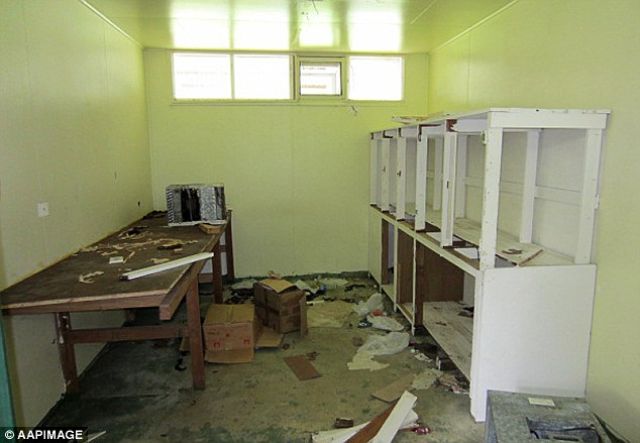
Every day, Manus Island detainees negotiate rocky ground strewn with coral, rotting shower blocks and “filthy” living conditions.
They do this mostly in rubber thongs. A cut foot is likely, septicemia possible and a heart attack followed by a coma and brain death?
Wait a minute, let’s go back.
A report by Amnesty International released last December, This is Breaking People — exposing the human rights violations at the refugee detention centre on Papua New Guinea’s remote northern island — said most of the men there had no shoes. “I put in 10 requests for shoes,” one Pakistani man said. “Someone told me that there are only 14 pairs available … I asked the IHMS [International Health and Medical Services] doctor and the doctor said TSA [The Salvation Army] had told him there were no more shoes.”
Amnesty said: “Most asylum seekers receive one or two T-shirts, one or two pairs of shorts, two pairs of underwear, and one pair of socks. Almost all are given flip-flops but no shoes … Shoes are traded for cigarettes and other items … [and] are sometimes shared so that asylum seekers can participate in walks outside the centre.”
This detail about shoes came with more than 120 pages of descriptions and witness testimony of the camp: from the lack of safe footwear, to broken shower and toilet facilities, to worms — and apparently a human tooth — in the food.
The report went on to detail medical services so under-resourced that seven medical professionals dealt with 110 medical requests a day. Staff of the private company that administers medical care for detainees, IHMS, told Amnesty that requests for transfer, follow-up care and more supplies were often refused or ignored by Australian immigration.
“A number of detainees raised concerns that sometimes it takes between three and 10 days to receive a medical appointment after submitting a request,” the report said. “Some felt that they needed to make several requests in order to be taken seriously and many complained that water and paracetamol was common treatment.”
Asylum seekers could not self-administer paracetamol or antiseptic cream for minor cuts. They would have to return to the medical clinic multiple times, which is often delayed or prevented due to queues, delays at the gate or the discretion of guards.
As soon as Manus Island detention centre was reopened in 2012, refugee supporters knew tragedy would be just around the corner. Miscarriages and suicide attempts were the first to occur. Then the bashing death of Reza Berati, which appalled many in Australia.
But no one would have assumed a death like 24-year-old Hamid Khazaei’s on September 5, ultimately the result of an untreated cut foot. Yet looking at the warnings and signs — Amnesty’s report and rising numbers of former workers turned whistleblowers — it really does feel so inevitable as to be almost deliberate.
A former G4S security guard who quit in disgust in June leaked photos to ABC news on September 7 that showed wet, dirty and broken showers. He described conditions as “filthy” and smuggled photos out so he could prove it. “Often [the men would] be standing on concrete to have a shower that was literally falling apart underneath them, just completely rotting away.”
The photos are significantly worse than those taken by the first refugees to arrive in January last year, when women and children were still living with the men in the facility.
Dr John Vallentine, formerly employed by IHMS at the Manus camp, told Four Corners soon after the photos came out that the camp was “just a disaster, medically”.
“These people really ought not be there,” he said. “They ought not be in Manus Island. It's just too remote and the medical facilities are quite inadequate.”
Khazaei’s family, who made the decision from Iran to turn off his life support, has enlisted lawyer Ruth Hudson to investigate a case for negligence.
“There is a possibility there was an inadequate initial diagnosis, potential failure to transfer him quickly enough to Australia; and also a failure to provide adequate treatment,” she told ABC’s AM.
“Unfortunately, there has not been a great deal of information provided prior to Hamid being transferred to the Mater [hospital in Brisbane]. So there is still some question as to the specific timeframe.”
Hudson plans to fight for an independent inquiry into the death.
Khazaei reportedly struggled to get treatment for his cut foot for three weeks before septicemia and complications finally led to his death. But the under-resourced medical staff are not to blame.
Rather, Khazaei fought a “chain of human rights violations” — as new United Nations High Commissioner for Human Rights Zeid Ra’ad Al-Hussein described Australia’s treatment of asylum seekers — and lost to a heartless system.
Offshore processing is a deliberately cruel and negligent policy. It is more punishment than processing, and no compromise is possible. The warning signs have to be heeded and Manus Island and Nauru detention camps must be shut down immediately, or more tragedies will follow.
Like the article? Subscribe to Green Left now! You can also like us on Facebook and follow us on Twitter.